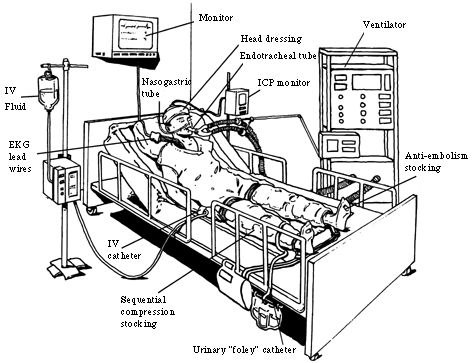What equipment will you see when you visit?
Depending on the type of brain injury, different kinds of equipment will be used. Some common equipment is shown in the picture below. Ask a member of the health care team if you have any questions about equipment.

Monitoring equipment for brain injuries
- Monitor
- A machine that shows heart rate, breathing, blood pressure, intracranial pressure, and cerebral perfusion pressure.
- Head dressing
- A bandage around the head used to keep the wound or incision clean and dry.
- ICP monitor
- A small tube placed into or just on top of the brain through a small hole in the skull. This will measure the amount of pressure inside the brain (intracranial pressure).
- Nasogastric tube (NG)
- A tube placed through the nose into the stomach that can be used to suction the stomach or provide liquid formula directly into the stomach.
- Endotracheal tube
- A tube inserted through the patient's nose or mouth into the trachea (windpipe) to help with breathing and suctioning.
- EKG lead wires
- Wires connected to the chest with small patches that measure the heart rate and rhythm.
- Intravenous catheter (IV) and intravenous fluid
- A flexible catheter which allows fluid, nutrients, and medicine to be given directly into a vein.
- Ventilator
- A machine used in the Intensive Care Unit to support the patient in their own breathing or give the patient breaths.
- Anti-embolism stockings (frequently call TEDS)
- Long white stockings used to help prevent the pooling of blood in the legs.
- Sequential compression stockings (frequently called Kendalls)
- Plastic leg wraps that help prevent blood clots by inflating and deflating around the legs.
- Urinary “foley” catheter
- A tube inserted into the bladder to drain and allow for accurate measurement of urine.